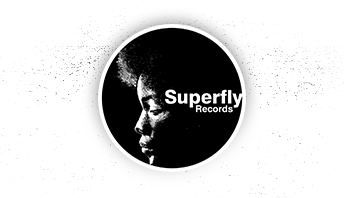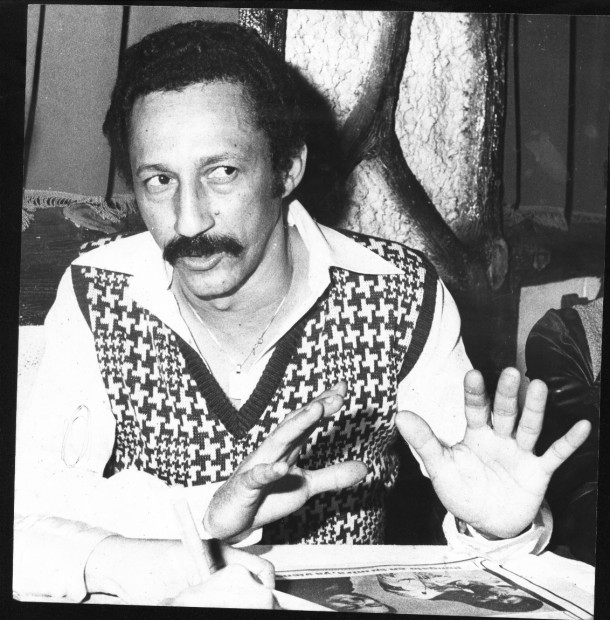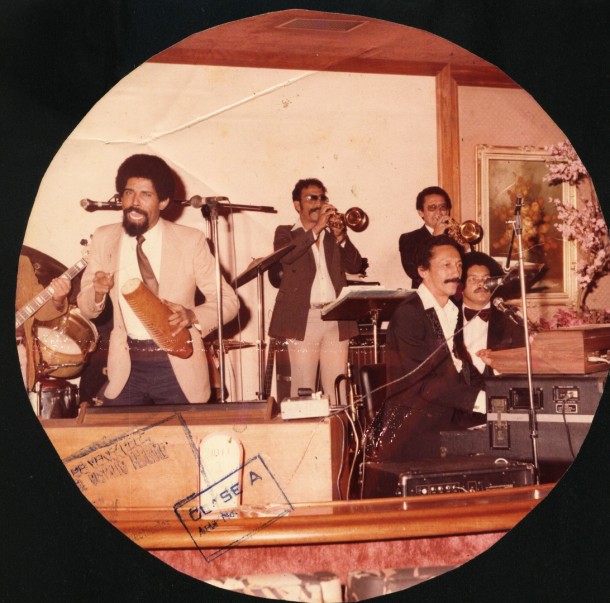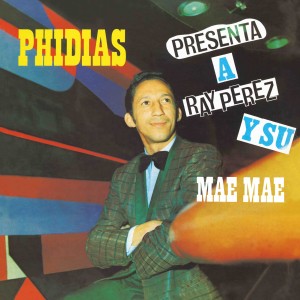



The most soulful Salsa record you will ever hear, from the sweetest singer ever, good from start to finish… Venezuelan Salsa as good as it gets!
Here you hold in your hands a brilliant fragment of time in the career of a still under appreciated genius of the afro-caribbean piano. The time was 1969, the place Caracas, Venezuela. Ramon Epiphanio (“Ray”) Perez, recently returned from NY to reconstitute his hard hitting, trombone-led “salsa dura” group Los Dementes. “Salsa” was a brand-new term at that point to describe the new generation of urban Afro-Caribbean musicians’ versions of the dance genres of Guaracha, Mambo, Montuno, Guajira, Cha-cha, Dancehall Guaguanco and others. In fact, the massively popular radio host presenting Ray’s new group is rightly credited with popularizing the term for his listening public and soon the world: Phidias Danilo Escalona.
The deep and raspy voiced, bushy-moustached (thus “el Bigoton”) Phidias had begun spinning guarachas and montunos on the radio in the mid 50s. By 1966 his show on Radio Difusora Venezuela, sponsored by “Salsa Pampero” tomato sauce, became “La hora de la Salsa, el Sabor y el Bembé”. He was quick to recognize a local genius like Ray Perez, and played his songs on his show. At seventeen and upon his father’s death, Ray migrated from Oriente province to Caracas with his family right around the time of the fall of the Venezuelan strongman Marco Pérez Jimenez. Ray bought a guitar and started to play and compose, even making music while bored at his job at the Remington adding machine company: “I put the calculators on different operations, 99, 01, like that, and each one had a rhythm… I synchronized them to make music, they would go “takata takata tit tit tit…”

By the mid-‘60s, Ray’s tumbao could be heard in Caracas with his newly formed “Los Dementes”, which included the Quintero brothers on percussion and an excellent local sonero Pedro “Perucho” Torcat. Perucho, whose voice would in time be much appreciated throughout the Salsa world, had a his career cut short when he died tragically in an accident at Justo Betancourt’s house in Boston, 1972. He was only 28 years old.
Mention must be made of how punk rock it was to name a group “Los Dementes” in conservative Caracas in the mid-‘60s: indeed, for a while Ray’s group was forbidden to perform using the name. But perform they did, on radio and soon TV, recording four excellent LPs by 1969 and building a strong following. Meanwhile Ray had somehow also found time to record the brilliant avant-garde side projects “Los Calvos” (1&2) with Frank “el Pavo” Hernandez on drums and the jazzy sonero Calaven singing, and “Los Kenya” with folkloric percussion maestro Alberto Naranjo.
After this intensely productive period, Ray decamped to New York, the afro-latin music capital of the world, taking his smoky, bluesy piano stylings in his fingertips. There he met up with Johnny Pacheco and played with the hottest local talent, even sold a couple of his compositions to the likes of Pete “Boogaloo” Rodriguez. Upon his return in late 1969, he formed his Pyraphon label – the LP you hold in your hands is one of the label’s first productions.

Standouts on the LP include “Emae Emae”, with the deeply meditative piano montuno and sound advice: “Si quieres amigo mio llegar a viejo, no bonches todos los dias porque no es bueno, busca siempre de los ancianos un buen consejo, se sencillo Buena gente y sin complejos” (Friend of mine, if you want to live a long life, don’t party every day because it’s not good, always look for a good word from your elders, be simple, a good person, without complexes).
Also “Asi mueren los valientes” (How the Brave ones die), a quintessentially macho salsa trombone masterpiece: “Asi mueren los valientes, asi quiero morir yo, con un machete en la mano, peleando por un amor” (That’s how the brave ones die, that’s how I want to die, with a machete in hand, fighting for a love”). But is it macho? At various times in the song, Ray adds ad-libs which seem to question the wisdom of dying violently instead of living to fight another day. Ray, by the way, sings and plays piano on the entire LP.
Finally, perhaps the heaviest version of “El Alacran” (“Oye colega no te asombres cuando veas…”) that you will hear. This number, an Afro-Cuban standard known as “Tumba la Caña”, was the calling card of the carnaval Comparsa “El Alacran” led by Santos Ramirez, and associated with the Conservative party in Cuban politics. Ray turns this into a fierce, trombone-led dancehall number with a nice smoky piano solo in the middle.
Coda on Phidias – the esteemed Venezuelan periodista Alfredo Churion told me that upon his death in 1985, El Bigoton’s wife threw his entire massive, priceless record collection on the street in front of their apartment in Caracas. Churion was able to grab a few armfuls on his way home.
by Roberto Ernesto Gyemant
San Francisco, CA
August 2016
Bro, I don’t even know you personally, but just from the opening sentences from this blog post , I can tell we both share a common appreciation for El Maestro Perez. Awesome work! Thanks for sharing.